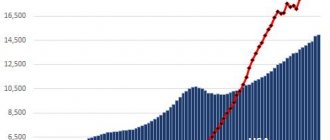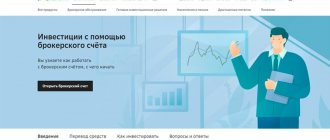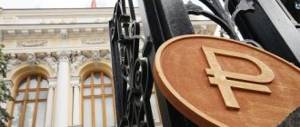Roman Averin
6.8k
What is the key interest rate of the Bank of Russia and other countries - What does it affect and when does the Central Bank raise it and when does it lower it? What happens during sudden changes and what is the size of the key rate in Russia and foreign countries.
Information from the Bank of Russia on the key rate is of great interest to financial analysts and professional investors, since this indicator directly affects the cost of providing banking services.
In addition, the key rate is a kind of control lever that the Government uses to maintain the stability of the country's economy.
What is a key rate
Key rate
- this is an extremely low interest rate used by the Central Bank of Russia to provide funds to credit institutions on the terms of urgency, payment and repayment (the loan period is 7 calendar days). At the same time, the Bank of Russia key interest rate is the highest interest rate at which commercial banks can place funds on deposit with the Central Bank of the Russian Federation.
Key rate in simple words
- this is the lowest interest rate at which the Central Bank can issue a short-term loan (
for a period of no more than one week
) to a commercial bank in order for it to carry out its activities in the field of lending - providing loans to individuals, entrepreneurs and companies. And also the maximum interest on the deposit if commercial banks transfer their funds for the purpose of safety and income generation to the Central Bank of Russia.
Wikipedia says that the key rate is both the maximum and minimum interest rate (depending on the type of operation) that the Central Bank of the Russian Federation uses to interact with commercial credit institutions.
Comments: 1
Your comment (question) If you have questions about this article, you can tell us. Our team consists of only experienced experts and specialists with specialized education. We will try to help you in this topic:
Author of the article Dmitry Sysoev
Consultant, author Popovich Anna
Financial author Olga Pikhotskaya
- Vladislav
07/16/2020 at 16:34 The article does not correspond to reality at all.
In Europe, loans from 1.99 percent. 1.99-3.50 is now the average loan. And for some reason they lowered the rate for Russian banks VTB. On the contrary, they have the highest of all, the real percentage is 17-19 now. Reply ↓
Bank of Russia interest rate for today
Information about what key rate of the Bank of Russia is relevant today is posted on the official portal of the Central Bank of the Russian Federation (https://www.cbr.ru/) at the beginning of the news feed.
Additional information provided by the press service of the Bank of Russia and which is closely related to the “key rate” indicator can be obtained by clicking on the link of the same name. Thus, you can find out information about the level of interest rates on Bank of Russia operations, inflation dynamics and risks, economic activity, etc.
The key rate of the Bank of Russia today is the subject of bargaining between the Central Bank of the Russian Federation and the Ministry of Economic Development. The Central Bank mainly focuses on inflation, while the Ministry operates with the real needs of the economy, which needs “cheap” money expressed in inexpensive loans.
Since March 26, 2021, the key rate of the Bank of Russia has been fixed at 7.25 percent per year, and over the past 3 years there has been a persistent downward trend in this type of interest rate. It is worth noting that the indicators lower than the current ones were set by the Central Bank only at the time the “key rate” indicator was introduced (September 13, 2013) and were valid until the first half of 2014.
The key rate of the Bank of Russia has undergone significant changes. For example, the sharpest and most significant jump in the interest rate to 17 points was observed at the end of 2014. Days of such dramatic changes in narrow circles are labeled “Black Monday” and “Black Tuesday.”
In general, the dynamics of the Bank of Russia key rate are presented as follows:
Dynamics of the Bank of Russia key rate
| Coming into effect | Magnitude |
| September 13, 2013 | 5,5 |
| 03 March 2014 | 7,0 |
| April 28, 2014 | 7,5 |
| July 28, 2014 | 8,0 |
| 05 November 2014 | 9,5 |
| December 12, 2014 | 10,5 |
| December 16, 2014 | 17 |
| 02 February 2015 | 15 |
| March 16, 2015 | 14 |
| 05 May 2015 | 12,5 |
| June 16, 2015 | 11,5 |
| 03 August 2015 | 11 |
| June 14, 2016 | 10,5 |
| September 19, 2016 | 10 |
| March 27, 2017 | 9,75 |
| May 02, 2017 | 9,25 |
| June 19, 2017 | 9,0 |
| September 18, 2017 | 8,5 |
| October 30, 2017 | 8,25 |
| December 18, 2017 | 7,75 |
| February 12, 2018 | 7,5 |
| March 26, 2018 | 7,25 |
The table of evolution of the key rate of the Central Bank of Russia reflects the degree of influence of the Government of the Russian Federation on economic activity in the country.
What does the interest rate affect?
Key rate of the Bank of Russia ( used in the Russian Federation since September 2013
) affects interest on bank loans and deposits for the population, is one of the tools for indirect government regulation of inflation, and also affects:
- Cost of funding (raising financial resources) of credit institutions;
- Economic growth rate;
- Volumes of money in the economy;
- Bank liquidity.
In a broad sense, the key rate is a fundamental concept for the global financial market. The main legislators here are the US Federal Reserve System (FRS), the Bank of England, the European Central Bank (ECB), and the Bank of Japan. Naturally, the largest stock markets operate in these countries and the EU. Therefore, investors are looking forward to the next decisions of the mentioned financial regulators. The value of the Bank of Russia key rate is minimal in a global sense and has a purely local effect, which to some extent extends to neighboring countries with which Russia has special economic relations.
The key rate set by the Bank of Russia is the main regulator of important economic processes. On its basis, the retail price for banking services of commercial banks is formed, the level of inflation is regulated and the devaluation process is adjusted, and the maximum key rate plays an important role in maintaining the stability of the country’s economy as a whole.
The tariffs of commercial banks for credit and deposit transactions are based on the key rate of the Bank of Russia, which, as a rule, increases by several percentage points (each bank independently determines the amount of the markup). Thus, the lower the key rate, the more accessible loans and borrowings become, but it is less profitable to place your own funds on deposit, since interest on deposits also decreases accordingly.
The opposite situation can provoke a reasonably low cash circulation, since the use of credit funds may not be available to every client due to its high cost, and high interest on deposits encourages the preservation of personal savings and increasing income.
Depending on what part of the funds the Central Bank of Russia is able to put into circulation through commercial banks and what income they will bring in the market for goods and services, the stability of the financial environment and the level of inflation directly depend.
When the Central Bank of the Russian Federation lowers interest rates
A decrease in the key interest rate always indicates economic prosperity, as well as the development of domestic production. The low cost of borrowed funds provides an opportunity for all commercial credit institutions to receive urgent loans from the Central Bank of the Russian Federation in order to further use this monetary resource to carry out their activities.
Since credit funds are issued to banks at low interest rates, banks, in turn, are ready to provide loans to the general public on more favorable terms. Loans are becoming available to large organizations, small firms, as well as a large number of individuals. This situation encourages business expansion, increased production volumes, the development of healthy competition, increased demand and, consequently, leads to a significant increase in the flow of money in the market.
Based on the above, we can conclude that the development of the national economy as a whole has been positive since February 2015, when the Bank of Russia reduced the key rate for the first time after a significant jump in the indicator by six and a half percent.
Why does the Central Bank of the Russian Federation increase its key rate?
Raising the key rate of the Bank of Russia helps slow down inflation and reduce devaluation risks. In 2014, the Central Bank repeatedly increased the interest rate. If on April 28, 2014 it was 7.5% per annum, then in December of the same year it rose to 17%. Russians remembered those pre-New Year days for the empty shelves of household appliance stores, as many compatriots, seeing the rise in exchange rates, sought to quickly get rid of rubles, spending them on expensive equipment before it became even more expensive.
As a rule, the lower the value of the key rate of the Central Bank of the Russian Federation, the higher the country’s welfare is assessed. However, circumstances often arise in which an increase in the interest rate is the only mechanism for influencing the situation in order to maintain economic stability.
One of the striking examples when an increase in the key rate of the Bank of Russia helps prevent the development of an economic crisis is the loss of position of the national currency or its depreciation.
The fact is that the low interest rate set by the Bank of Russia encourages commercial banks to attract borrowed funds, which they can subsequently use to carry out foreign exchange transactions. Purchasing foreign currency in large quantities has a negative impact on the value of the national currency and can lead to the start of an inflationary process.
On the other hand, a high value of the key rate indicator interferes with the normal development of business and production, and the economy of the entire country and its population directly suffer from this. Therefore, an increase in the key rate of the Bank of Russia is an extremely undesirable, but sometimes urgently necessary measure.
What does sudden change entail?
It is generally accepted that the normal “step” of the key rate movement does not exceed 0.5 percentage points.
However, when the growth of the indicator picks up an unprecedented speed and the interest rate increases by more than half a percent at a time and such an increase in the rate occurs quite often over a relatively short period of time or a sharp increase in the rate is observed, we can most likely talk about the beginning of a financial crisis.
Changes accompanying a sharp increase in the key rate
:
- Increased activity of the population (purchasing foreign currency, purchasing goods for future use in order to get rid of cash);
- Significant increase in prices for goods and services;
- Mass declaration of bankruptcy of enterprises.
As a rule, a sharp jump in the key interest rate reflects the measures taken by the Government in relation to a steadily threatening increase in the level of inflation and a decrease in the value of the ruble.
Main interest rate benchmark
The value of the “key rate” indicator is registered by the Central Bank of the Russian Federation at a meeting of the board of directors, and the level of inflation in the country is primarily taken into account.
A decrease in the rate of price growth in the market for goods and services in the reporting period leads to a decision to reduce the key interest rate, since this trend is characteristic of a reduction in the volume of money turnover within the country. And loans on favorable terms allow large and small companies to develop their business and increase production volumes.
The opposite situation is when inflation quickly consumes the market and many goods become inaccessible to certain segments of the population due to inflated prices, then the Government takes measures to resolve the situation. A small surcharge on the key rate allows you to contain the level of inflation; its size depends on the rate of price growth in the market. Sometimes a one-time increase in the key interest rate is not enough and measures of this nature are applied by the Bank of Russia as necessary (a typical picture in 2014).
Using this “lever” of control, the Central Bank reduces the flow of borrowed funds, which are not always accumulated within the country and generate income for it, but are spent on the purchase of foreign currency and the purchase of goods from abroad.
Useful links:
- Virtual card: What is it and where to open it, How to use and spend money
- The truth about the Tinkoff Platinum card - secrets, reviews and answers
- What is an account and bank IBAN - How to find and decrypt it
- What is SWIFT in simple words and how the system works
Key rates in other countries
It is worth noting that most countries with developed economies, in terms of the interest rate set by the Central Bank of the corresponding country, occupy a more advantageous position than Russia.
Countries in a stable economic situation ( in accordance with the size of the key rate
):
Table of interest rates in different countries
| Name of the rate | Leading countries of the world | Interest rate | Effective date |
| Three-month Llibor rate range | Switzerland | -0,75 | 15.03.2018 |
| Target overnight interest rate | Japan | -0,1 | 27.04.2018 |
| Deposit rate | Eurozone | 0 | 26.04.2018 |
| Interest rate | Britannia | 0,5 | 10.05.2018 |
| Target overnight interest rate | Canada | 1,25 | 18.04.2018 |
| Interest rate | Australia | 1,5 | 01.05.2018 |
| Federal Reserve | USA | 1,75 | 02.05.2018 |
| Interest rate | New Zealand | 1,75 | 10.05.2018 |
Countries that also have low leading key rates:
- Denmark – (-0.65%);
- Sweden – (-0.5%);
- Germany – 0%;
- France – 0%;
- Italy – 0%;
- Spain – 0%;
- Netherlands – 0%;
- Belgium – 0%;
- Austria – 0%;
- Ireland – 0%;
- Finland – 0%;
- Portugal – 0%;
- Israel – 0.1%;
- Norway – 0.5%;
- Taiwan – 1.38%;
- Singapore - 1.47%;
- South Korea – 1.5%;
- Poland – 1.5%;
- Thailand - 1.5%;
- UAE – 2%;
- Hong Kong - 2%;
- Saudi Arabia – 2.25%;
- Chile – 2.5%;
- Philippines - 3.25%;
- Malaysia – 3.25%;
- Colombia - 4.25%;
- China – 4.35%;
- Indonesia – 4.75%;
- India – 6%;
- Vietnam – 6.25%;
- Brazil – 6.5%;
- South Africa - 6.5%;
- Pakistan – 6.5%;
- Bangladesh – 6.75%.
However, there are countries that apply a key rate higher than in the Russian Federation (7.25%). For example, Mexico - 7.5%, Turkey - 8%, Nigeria - 14%, Egypt - 16.75%, Iran - 18%, Venezuela - 21.7% and Argentina - 40%.
It is important to understand that the interest rate of the Central Bank of Russia, even in its original and lowest form (5.5%) was higher than the current rates in many countries of the world.
The difference between the key rate and the refinancing rate
First of all, it should be noted that the refinancing rate was first announced in 1992 and until September 2013 served as the main guideline for constructing monetary policy.
The key rate of the Bank of Russia can be conditionally called the successor of the refinancing rate, since after its introduction the dominant role passed to it, and the refinancing rate at the present time is more of an informational nature and is used to calculate secondary indicators.
In practice, the refinancing rate is used
:
- To establish the need to calculate tax on deposits. Deposits with an interest rate exceeding the refinancing rate by 5 positions in ruble equivalent and by 9 percentage points in foreign currency are subject to taxation.
- To calculate penalties for overdue debts when paying taxes. Calculated daily as 1/300 of the current refinancing rate.
- To determine the interest rate under the concluded agreement, if it was not determined at the time of the agreement. The rate that was in effect on the date of conclusion of the contract is taken into account.
- To calculate penalties that apply to organizations in case of failure to meet the deadlines for paying wages to employees, as well as amounts for sick leave, vacation pay and other payments. It is calculated in the same way as a tax penalty, that is, in proportion to 1/300 of the refinancing rate.
The dynamics of this indicator also have a wide step range; the refinancing rate acquired its extremely low value (7.25) at the beginning of January 2021, when it was brought into line with the key rate of the Central Bank of the Russian Federation.
This level remains the same at the current time, however, the rate has repeatedly reached peak levels: in October 1993 - 210%, in May 1994 - 200%, in January 1995 - 200%, in February 1996 - 120%, in May 1998 – 150%.
It is interesting that the dynamics of the Bank of Russia key rate indicator carries an important information component of changes in the national and foreign exchange markets, as well as the rate of inflation growth. Such information can be useful to many investors who use financial movements to make a profit.
News
Top Stories of the Week: Trump in Davos and NetflixInvesting.com Report - 01/20/20201
By Noreen BurkeInvesting.com - Busy week ahead as the Eurozone, Japan and Canada host their first central bank meetings to set the tone for 2021. US President Donald...
Top world news for TuesdayInvesting.com - 07/30/2019 Investing.com - Introducing the top 5 financial market news on Tuesday, July 30, 2021Investing.com - Introducing the top 5 financial market news on Tuesday, July 30, 20211... .
Gold prices rise ahead of Fed decisionInvesting.com - 07/29/2019 Investing.com - Gold prices rose slightly on Monday amid forecasts that the Federal Reserve will cut interest rates this week.By 15:55 Moscow time, August gold futures...
Functions[edit | edit code]
The Bank of Japan performs the following functions:
- issue of banknotes;
- implementation of monetary policy (changes in the required reserve ratio, operations in financial markets, regulation of the discount interest rate);
- carrying out mutual settlements between commercial banks;
- monitoring and auditing the financial position and management of financial institutions;
- conducting transactions with government securities;
- carrying out international activities;
- performing economic analysis and conducting theoretical research.
Japan's credit rating from Standard Poor's
Japan's credit rating from Standard Poor's is A+, like Ireland, Chile, China, and Slovakia.
- Higher AA ratings are in the UK, France, Belgium, South Korea, Kuwait;
- Below with an A- rating are Spain, Malta, Poland, Saudi Arabia.
The A+ rating belongs to the investment class and means a moderate ability to timely and fully fulfill debt obligations, but high sensitivity to negative changes in financial, commercial, and economic conditions.











